This content has been machine translated dynamically.
Dieser Inhalt ist eine maschinelle Übersetzung, die dynamisch erstellt wurde. (Haftungsausschluss)
Cet article a été traduit automatiquement de manière dynamique. (Clause de non responsabilité)
Este artículo lo ha traducido una máquina de forma dinámica. (Aviso legal)
此内容已经过机器动态翻译。 放弃
このコンテンツは動的に機械翻訳されています。免責事項
이 콘텐츠는 동적으로 기계 번역되었습니다. 책임 부인
Este texto foi traduzido automaticamente. (Aviso legal)
Questo contenuto è stato tradotto dinamicamente con traduzione automatica.(Esclusione di responsabilità))
This article has been machine translated.
Dieser Artikel wurde maschinell übersetzt. (Haftungsausschluss)
Ce article a été traduit automatiquement. (Clause de non responsabilité)
Este artículo ha sido traducido automáticamente. (Aviso legal)
この記事は機械翻訳されています.免責事項
이 기사는 기계 번역되었습니다.책임 부인
Este artigo foi traduzido automaticamente.(Aviso legal)
这篇文章已经过机器翻译.放弃
Questo articolo è stato tradotto automaticamente.(Esclusione di responsabilità))
Translation failed!
HDX™ screen sharing
Overview
The Linux VDA lets you share the screen of your virtual desktop with session users on other virtual desktops.
The following example walks you through the procedure of sharing a screen and viewing someone else’s screen.
To share a screen:
-
In the notification area of your virtual desktop, click the following system tray icon and select Screen sharing > Share my screen.


-
Click Copy and Close.
The current screen sharing code persists until you stop and restart sharing your screen.
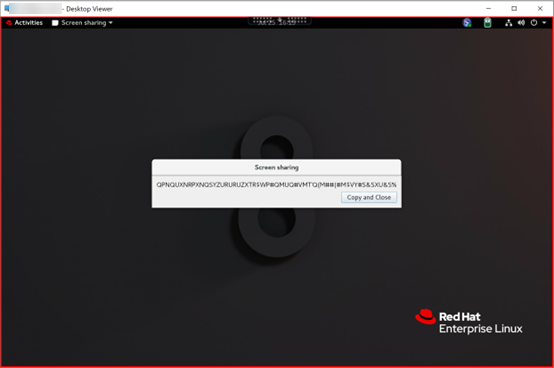
Tip:
While you are sharing your screen, there is a red border around it, indicating that sharing is in progress.
-
Share the copied code with session users on other virtual desktops that you want to share your screen with.
-
To let a viewer control your screen, select Give control and then the viewer’s name. To stop giving control, clear the viewer’s name.
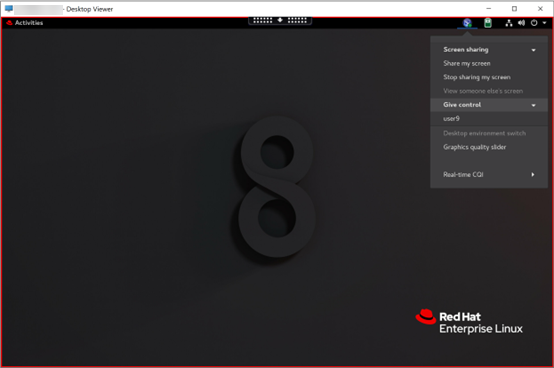
-
To stop sharing your screen, select Stop sharing my screen.
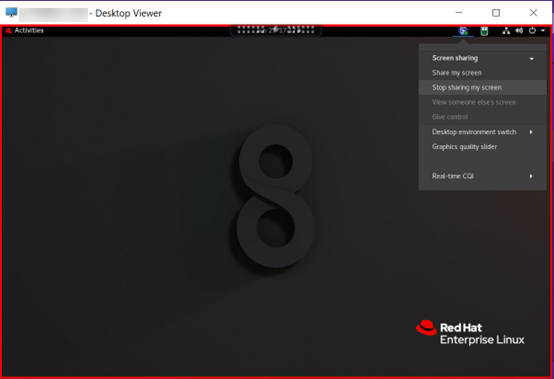
To view someone else’s screen:
-
In the notification area of your virtual desktop, click the screen sharing icon and select View someone else’s screen.
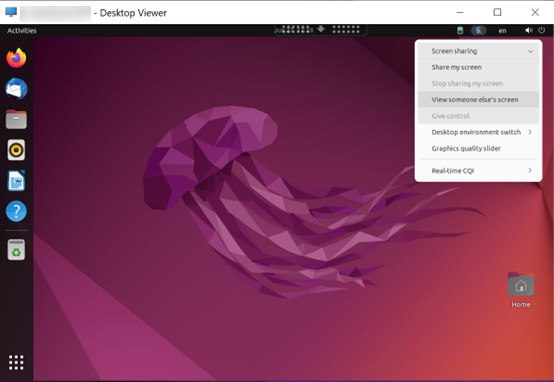
-
Enter the connection code of the screen that you want to view and then click Connect.
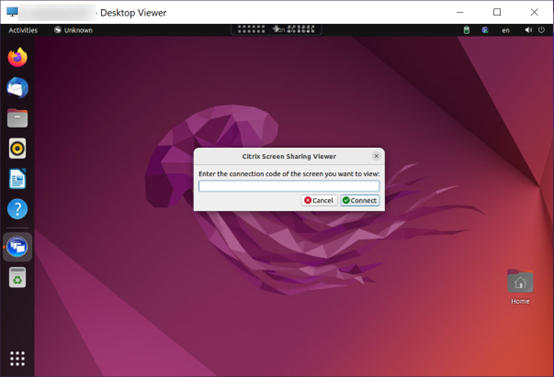
-
Wait for the screen sharer to accept your request. For example:
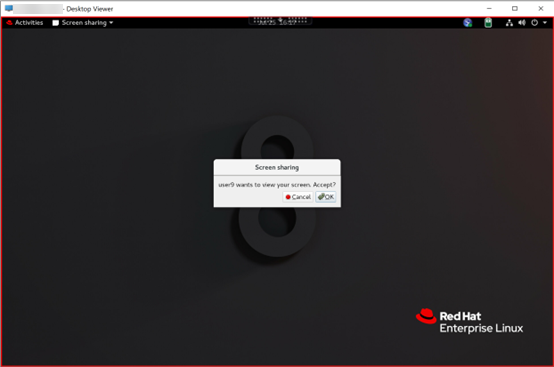
Tip:
- On the sharer side, the Linux system issues a notification of your request.
- If the sharer does not accept your request within 30 seconds, your request expires and a prompt appears.
-
After the screen sharer accepts your request by clicking OK, the shared screen appears in your Desktop Viewer. You are connected as a viewer with an automatically assigned user name.
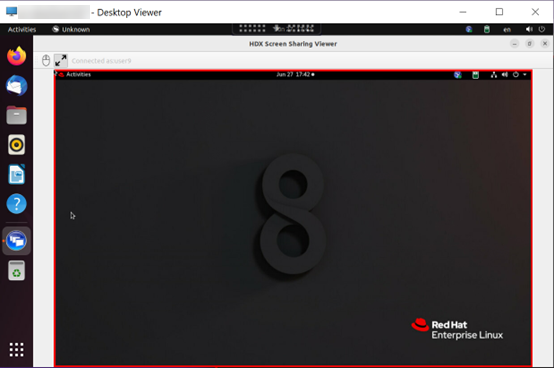
-
To request control over the shared screen, click the mouse icon in the upper left corner.
Tip:
- If the sharer does not accept your request within 30 seconds, your request expires.
- Only one viewer is allowed to control a shared screen at a time.
Click the mouse icon again to release control over the shared screen.
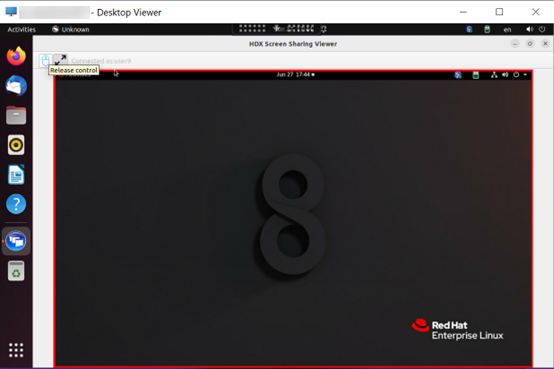
-
To disable display scaling or scale to the window size, click the icon next to the mouse icon.
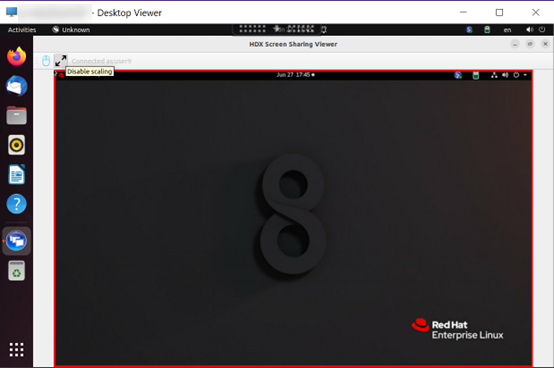
Configuration
The screen sharing feature is disabled by default. To enable it, complete the following settings:
-
For Citrix Virtual Apps and Desktops™ 2112 and later, enable the ScreenSharing policy in Citrix Studio.
-
(Optional) For Citrix Virtual Apps™ and Desktops 2109 and earlier, enable screen sharing on the Linux VDA by running the following command:
sudo /opt/Citrix/VDA/bin/ctxreg update -k "HKLM\System\CurrentControlSet\Control\Citrix\Thinwire" -v "EnableScreenSharing" -d "0x00000001" <!--NeedCopy--> -
Allow ports 52525–52625 in your firewall.
Considerations
-
The screen sharing feature does not support the H.265 video codec.
-
The screen sharing feature is not available for app sessions.
-
Users of desktop sessions can share their session screens with up to 10 viewers by default. The maximum number of viewers is configurable through
ctxreg update -k "HKLM\System\CurrentControlSet\Control\Citrix\Thinwire" -v "ScreenSharingViewerMaxNum" -d <hex_value>. When the maximum number is reached, a prompt appears when users try to accept extra connection requests.
Share
Share
In this article
This Preview product documentation is Citrix Confidential.
You agree to hold this documentation confidential pursuant to the terms of your Citrix Beta/Tech Preview Agreement.
The development, release and timing of any features or functionality described in the Preview documentation remains at our sole discretion and are subject to change without notice or consultation.
The documentation is for informational purposes only and is not a commitment, promise or legal obligation to deliver any material, code or functionality and should not be relied upon in making Citrix product purchase decisions.
If you do not agree, select I DO NOT AGREE to exit.